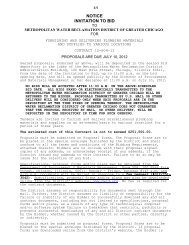Report - Metropolitan Water Reclamation District of Greater Chicago
Report - Metropolitan Water Reclamation District of Greater Chicago
Report - Metropolitan Water Reclamation District of Greater Chicago
You also want an ePaper? Increase the reach of your titles
YUMPU automatically turns print PDFs into web optimized ePapers that Google loves.
Endocrine Disrupting Compound Study. A three-year study commenced in March<br />
2009 to conduct a comprehensive assessment <strong>of</strong> the potential for endocrine disrupting<br />
compounds (EDCs) to impact the reproductive potential <strong>of</strong> fish populations in the CAWS. The<br />
objectives <strong>of</strong> this study are to determine (1) the spatial and temporal occurrence <strong>of</strong>EDCs; (2) the<br />
occurrence <strong>of</strong> endocrine disruption in wild fish populations; and (3) the likely sources<br />
contributing to any occurrence <strong>of</strong> endocrine disruption.<br />
<strong>Water</strong>way samples were collected from 38 AWQM stations and final effluent samples<br />
were obtained from all seven <strong>District</strong> treatment plants. These water samples were analyzed each<br />
quarter for total estrogenicity and a subset <strong>of</strong> common estrogenic compounds. The unanalyzed<br />
samples have been archived for future analysis as needed. Caged fish were deployed in selected<br />
CAWS waterways for at least two weeks during two periods in 2010 (April/May and<br />
September/October). Wild fish were also collected in May. Wild and caged fish were examined<br />
for endocrine disruption using histopathology and plasma vitellogenin analysis. Two successful<br />
deployments <strong>of</strong> the mobile exposure laboratory trailer (MELT) occurred in August and<br />
September <strong>of</strong> 2010. MELT will enable the study to evaluate whether a relationship between<br />
specific water sources and observed endocrine disruption exists, and identify the likely<br />
compounds responsible. Results will be published at the conclusion <strong>of</strong>this study in 2012.<br />
Wet Weather Fish Movement Study. A collaborative study with LimnoTech Inc. and<br />
the Illinois Natural History Survey (INHS) funded by the WERF began in 2010. The purpose <strong>of</strong><br />
this pilot study is to assess the effect <strong>of</strong> wet weather driven DO sags on CAWS fish. During the<br />
summer <strong>of</strong> 2010, fourteen acoustic hydrophone receivers were installed in Bubbly Creek, the<br />
South Branch <strong>Chicago</strong> River, the <strong>Chicago</strong> Sanitary and Ship Canal, and two <strong>of</strong>f-channel slips.<br />
Electronic tags were surgically implanted in 20 largemouth bass that were collected in or near<br />
Bubbly Creek. Twenty common carp were also tagged by INHS within the study area in<br />
cooperation with Asian carp monitoring activities occurring in the CAWS. The <strong>District</strong> will<br />
provide DO data from at least 5 continuous DO monitoring stations in order to determine<br />
whether tagged fish avoid low DO areas during wet weather events and, if so, where they<br />
relocate. A final report will be published on this research by early 2012.<br />
34
















